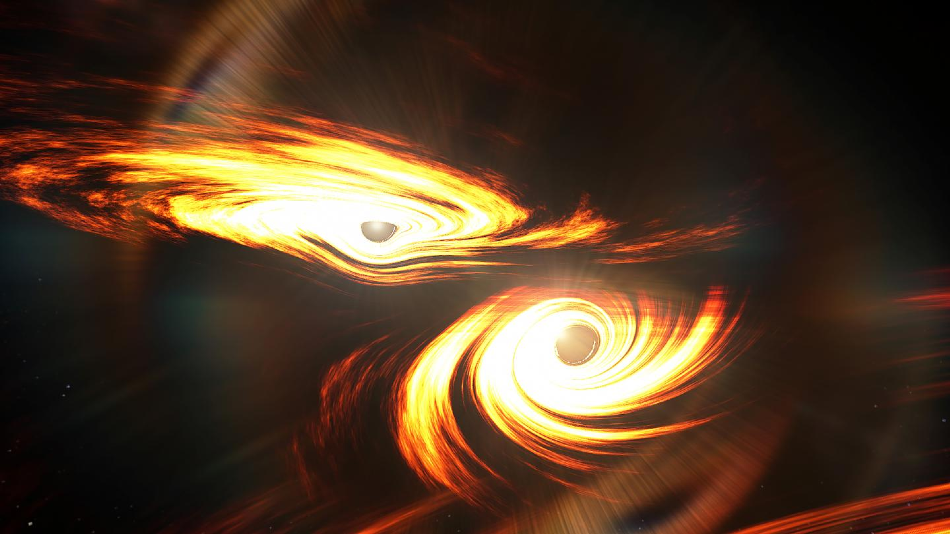Sep 3 2020
The LIGO and VIRGO Scientific Collaboration, which involves researchers from The Australian National University (ANU), has directly observed the largest giant black hole collision, for the first time.
 Artist’s impression of binary black holes about to collide. Image Credit: Mark Myers, ARC Centre of Excellence for Gravitational Wave Discovery (OzGrav).
Artist’s impression of binary black holes about to collide. Image Credit: Mark Myers, ARC Centre of Excellence for Gravitational Wave Discovery (OzGrav).
On May 21st, 2019, the LIGO and Virgo gravitational wave observatories in Europe and the United States detected the short gravitational-wave signal, GW190521, which emerged from two extremely spinning, massive black holes that have a colossal mass of 85 times and 66 times that of the Sun, respectively.
However, that is not the sole reason that makes this system very unique. The bigger one among the two black holes is believed to be “impossible.” Astronomers estimate that stars between 65 and 130 times the mass of the Sun go through a process known as pair-instability, causing the star to explode and without leaving any remnants.
The larger black hole with a mass of 85 solar masses falls directly in that forbidden range, called the upper black hole mass gap, and must be “impossible.” Therefore, if this black hole was not formed by the disintegration of a star, then how exactly did it develop?
We think of black holes as the vacuum cleaners of the Universe. They suck in everything in their paths, including gas clouds and stars. They also suck in other black holes and it is possible to produce bigger and bigger black holes by the ongoing collisions of earlier generations of black holes. The heavier ‘impossible’ black hole in our detected collision may have been produced in this way.
Susan Scott, Study Co-Author and Professor, Research School of Physics, The Australian National University
Both black holes combined when the Universe was just roughly seven billion years old, which is approximately 50% of its current age. These black holes developed an even larger black hole weighing as much as 142 times the mass of the Sun, making it the largest black hole to be ever visualized via gravitational wave observations.
Black holes with 100 to 100,000 solar masses are known as intermediate-mass black holes (IMBHs). These black holes are heavier than stellar-mass black holes but lighter than giant black holes usually positioned at the cores of galaxies. No definite electromagnetic observations were available for IMBHs that fall in the mass range of 100 to 1,000 solar masses.
The ‘impossible’ black hole formed by the collision lies in the black hole desert between 100 and 1,000 times the mass of the Sun. We are very excited to have achieved the first direct observation of an IMBH in this mass range. We also saw how it formed, confirming that IMBHs can be produced through the merger of two smaller black holes.
Susan Scott, Study Co-Author and Professor, Research School of Physics, The Australian National University
Professor Scott is also the Chief Investigator with the ARC Centre of Excellence for Gravitational Wave Discovery (OzGrav).
Another new study proposes that investigators using Caltech’s Zwicky Transient Facility could have detected a light flare from the collision. This is unexpected because black holes and their mergers are generally dark to telescopes. One notion is that the system could have been orbiting a giant black hole.
The recently created black hole could have received a push from the collision, shooting off in a new direction and gushing through the gas disk around the giant black hole, triggering it to illuminate.
There are a number of different environments in which this system of two black holes could have formed, and the disk of gas surrounding a supermassive black hole is certainly one of them. But it is also possible that this system consisted of two primordial black holes that formed in the early Universe.
Dr Vaishali Adya, The Australian National University
Dr Adya is also a postdoctoral researcher from OzGrav.
“Every observation we make of two black holes colliding gives us new and surprising information about the lives of black holes throughout the Universe. We are beginning to populate the black hole mass gaps previously thought to exist, with ‘impossible’ black holes that have been revealed through our detections,” Dr Adya concluded.
Journal Reference:
Abbott, R., et al. (2020) GW190521: A Binary Black Hole Merger with a Total Mass of 150 M⊙. Physical Review Letters. doi.org/10.1103/PhysRevLett.125.101102.